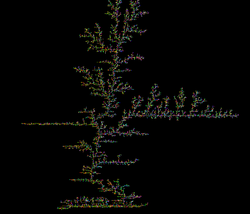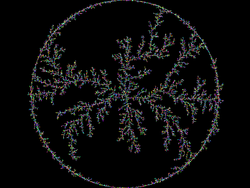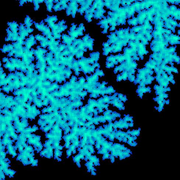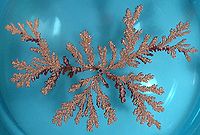
Brownian tree
Encyclopedia

Robert Brown (botanist)
Robert Brown was a Scottish botanist and palaeobotanist who made important contributions to botany largely through his pioneering use of the microscope...
via Brownian motion
Brownian motion
Brownian motion or pedesis is the presumably random drifting of particles suspended in a fluid or the mathematical model used to describe such random movements, which is often called a particle theory.The mathematical model of Brownian motion has several real-world applications...
, is a form of computer art that was briefly popular in the 1990s, when home computers started to have sufficient power to simulate Brownian motion
Brownian motion
Brownian motion or pedesis is the presumably random drifting of particles suspended in a fluid or the mathematical model used to describe such random movements, which is often called a particle theory.The mathematical model of Brownian motion has several real-world applications...
. Brownian trees are mathematical models of dendritic structures
Dendrite (crystal)
A crystal dendrite is a crystal that develops with a typical multi-branching tree-like form. Dendritic crystal growth is very common and illustrated by snowflake formation and frost patterns on a window. Dendritic crystallization forms a natural fractal pattern...
associated with the physical process known as diffusion-limited aggregation
Diffusion-limited aggregation
Diffusion-limited aggregation is the process whereby particles undergoing a random walk due to Brownian motion cluster together to form aggregates of such particles. This theory, proposed by Witten and Sander in 1981, is applicable to aggregation in any system where diffusion is the primary means...
.
A Brownian tree is built with these steps: first, a "seed" is placed somewhere on the screen. Then, a particle is placed in a random position of the screen, and moved randomly until it bumps against the seed. The particle is left there, and another particle is placed in a random position and moved until it bumps against the seed or any previous particle, and so on.


- the seed position
- the initial particle position (anywhere on the screen, from a circle surrounding the seed, from the top of the screen, etc.)
- the moving algorithm (usually random, but for example a particle can be deleted if it goes too far from the seed, etc.)
Particle color can change between iterations, giving interesting effects.
At the time of their popularity (helped by a Scientific American
Scientific American
Scientific American is a popular science magazine. It is notable for its long history of presenting science monthly to an educated but not necessarily scientific public, through its careful attention to the clarity of its text as well as the quality of its specially commissioned color graphics...
article in the Computer Recreations section, December 1988), a common computer took hours, and even days, to generate a small tree. Today's (2003) computers can generate trees with tens of thousands of particles in a few minutes.
These trees can also be grown easily in an electrodeposition cell, and are the direct result of diffusion-limited aggregation.


